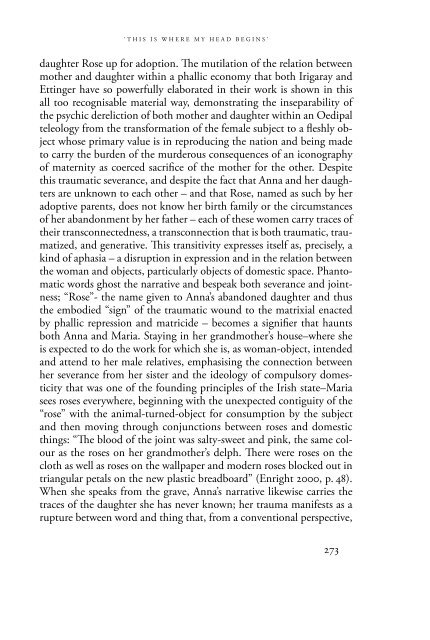Bodily proximity - Poligrafi.si
Bodily proximity - Poligrafi.si
Bodily proximity - Poligrafi.si
Create successful ePaper yourself
Turn your PDF publications into a flip-book with our unique Google optimized e-Paper software.
‘THIS IS WHERE MY HEAD BEGINS’<br />
daughter Rose up for adoption. The mutilation of the relation between<br />
mother and daughter within a phallic economy that both Irigaray and<br />
Ettinger have so powerfully elaborated in their work is shown in this<br />
all too recognisable material way, demonstrating the inseparability of<br />
the psychic dereliction of both mother and daughter within an Oedipal<br />
teleology from the transformation of the female subject to a fleshly object<br />
whose primary value is in reproducing the nation and being made<br />
to carry the burden of the murderous consequences of an iconography<br />
of maternity as coerced sacrifice of the mother for the other. Despite<br />
this traumatic severance, and despite the fact that Anna and her daughters<br />
are unknown to each other – and that Rose, named as such by her<br />
adoptive parents, does not know her birth family or the circumstances<br />
of her abandonment by her father – each of these women carry traces of<br />
their transconnectedness, a transconnection that is both traumatic, traumatized,<br />
and generative. This tran<strong>si</strong>tivity expresses itself as, precisely, a<br />
kind of apha<strong>si</strong>a – a disruption in expres<strong>si</strong>on and in the relation between<br />
the woman and objects, particularly objects of domestic space. Phantomatic<br />
words ghost the narrative and bespeak both severance and jointness;<br />
“Rose”- the name given to Anna’s abandoned daughter and thus<br />
the embodied “<strong>si</strong>gn” of the traumatic wound to the matrixial enacted<br />
by phallic repres<strong>si</strong>on and matricide – becomes a <strong>si</strong>gnifier that haunts<br />
both Anna and Maria. Staying in her grandmother’s house–where she<br />
is expected to do the work for which she is, as woman-object, intended<br />
and attend to her male relatives, empha<strong>si</strong><strong>si</strong>ng the connection between<br />
her severance from her <strong>si</strong>ster and the ideology of compulsory domesticity<br />
that was one of the founding principles of the Irish state–Maria<br />
sees roses everywhere, beginning with the unexpected contiguity of the<br />
“rose” with the animal-turned-object for consumption by the subject<br />
and then moving through conjunctions between roses and domestic<br />
things: “The blood of the joint was salty-sweet and pink, the same colour<br />
as the roses on her grandmother’s delph. There were roses on the<br />
cloth as well as roses on the wallpaper and modern roses blocked out in<br />
triangular petals on the new plastic breadboard” (Enright 2000, p. 48).<br />
When she speaks from the grave, Anna’s narrative likewise carries the<br />
traces of the daughter she has never known; her trauma manifests as a<br />
rupture between word and thing that, from a conventional perspective,<br />
273


